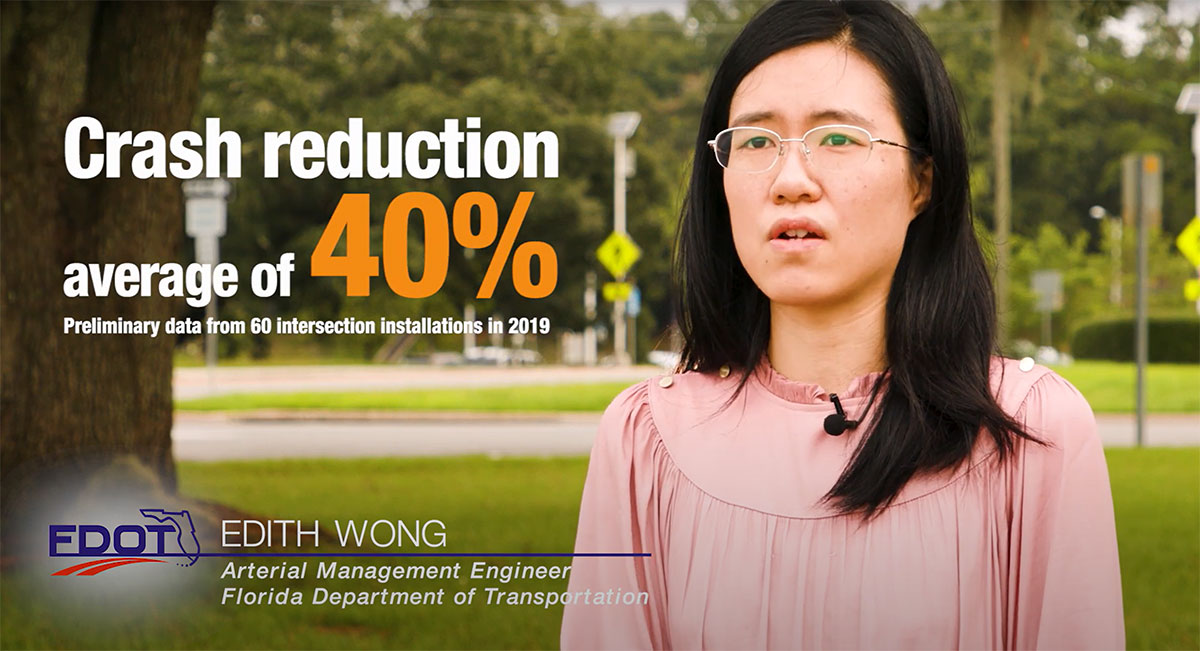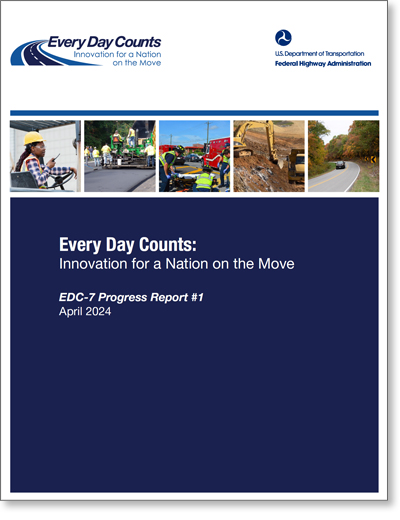September 19, 2024
Innovation of the Month: Shedding Light on Safety: Nighttime Visibility Initiative
FHWA’s nighttime visibility for safety initiative promotes traffic control device and lighting technology innovations to help make our roads safer for all users at night. Advancements in roadway lighting provide unique capabilities to enable non-motorized users to be more visible to drivers helping to avoid crashes resulting in injury or death. Modern roadway lighting is included as one of FHWA’s Proven Safety Countermeasures showing that lighting can reduce up to 42 percent of nighttime injury pedestrian crashes at intersections.
Modern roadway lighting technology such as Light Emitting Diodes (LED) provides a variety of advantages that conventional High-Pressure Sodium (HPS) lighting cannot provide. LED Lighting technology offers transportation professionals the ability to control the direction and quantity of light to illuminate pedestrian crossings without impacting the adjacent properties or creating unwanted skyglow and glare. LED lighting also emits a broader spectrum of light as compared to HPS lamps making it easier for drivers to see color differences during darkness. Using modern lighting technology improves the likelihood of a bicyclist or pedestrian being seen by enhancing both color and luminance contrast, and its cost to operate and maintain are significantly lower than HPS lighting, making this proven safety countermeasure more affordable.
 Credit: FHWA
Credit: FHWA In 2016, the Florida Department of Transportation (FDOT) established a lighting retrofit program to improve nighttime visibility at high-risk locations. This initiative targeted nighttime visibility improvements at approximately 2,500 intersections across the state by retrofitting or adding new LED lighting. FDOT has established policies that require lighting at all signalized intersections and midblock crossings without the need for a warrant analysis ensuring all pedestrian crossings will have established both horizontal and vertical illuminance levels. This helps pedestrians and non-motorized users be seen at night and help reduce fatalities and serious injuries in Florida. FHWA produced a short video in 2021 highlighting FDOT’s effort in addressing nighttime visibility for safety.
To stay up-to-date on this initiative, subscribe to the team’s e-newsletter. If you have additional questions, please contact a member of the team: Joseph Cheung, FHWA Office of Safety, or George Merritt, FHWA Resource Center.
PennDOT Utilizes Automated Traffic Signal Performance Measures (ATSPMs) to Improve Traffic Signals
With tens of thousands of traffic lights in Pennsylvania, it’s important that traffic signals are timed correctly to keep Pennsylvanians moving efficiently and safely. By adopting Automated Traffic Signal Performance Measures (ATSPMs), PennDOT can collect traffic signal data continuously to improve traffic signal timing and optimize the flow of traffic.
 Credit: PennDOT
Credit: PennDOTATSPMs are a suite of resources for collecting data on traffic signals, including equipment health, vehicle detection, and traffic flow. The data helps PennDOT understand how traffic signals are meeting safety and mobility objectives, directly analyze traffic signal operations, optimize signal timings, evaluate equipment performance, and more.
Prior to ATSPMs, signal retiming was a manual, labor-intensive process, which only captured a short period of time. Maintenance and operations relied heavily on inconsistent feedback from the public to know if signal detection was working properly.
PennDOT recently began a pilot ATSPM program that gathers signal operations data from 110 traffic signal intersections from across Pennsylvania. The program allows PennDOT employees and other stakeholders to see what changes can be made to optimize traffic signal efficiency. After the successful pilot, PennDOT hopes to expand the use of ATSPMs throughout the state.
To learn more, view more information on PennDOT’s ATSPM program or contact Steve Gault, TSMO Arterials & Planning Section Chief, PennDOT.
EDC-7 Progress Report Now Available
 Credit: FHWA
Credit: FHWAThe Every Day Counts Round 7 Progress Report is now available. This report describes the seven technologies and practices FHWA is promoting in EDC-7 and summarizes the deployment status of each innovation as of April 2024 and each innovation’s goal for adoption by 2025.
Has your State institutionalized next generation TIM or used internally cured concrete? Is it leading the way with strategic workforce development or EPDs for sustainable project delivery? Read the report to find out which States are implementing EDC-7 innovations and stay tuned to EDC News for updates and success stories.
Stay Up to Date on the EDC Innovations That Interest You Most

EDC teams are always on the move! If you blink, you could miss out on important webinars, case studies, tools, videos, and more. To never miss information for the EDC innovations that interest you most, visit the subscription page and select the topics you’d like to receive updates on directly from the teams that coordinate them.
Recent bulletins:
Strategic Workforce Development 9/5/24
Crowdsourcing 9/5/24
Upcoming Events
Lighting Design for an Urban Street Environment
October 29, 2024, 1:00-3:00pm ET Register
Nighttime Visibility for Safety - a Conversation with FHWA
November 12, 2024, 10:00-11:00am ET Register
About EDC
Every Day Counts, a State-based initiative of the Federal Highway Administration's Office of Innovation and Workforce Solutions, works with State, local, and privatesector partners to encourage the adoption of proven and underutilized technologies to deliver transportation projects more efficiently, enhance safety forall users, support a sustainable and resilient infrastructure, and incorporate equity inproject planning and delivery.
EDC News is a weekly publication highlighting successful EDC innovation deployments across the country.
EDC News is published weekly by the FHWA Center for Accelerating Innovation.
Disclaimer: The U.S. Government does not endorse products or manufacturers. Trademarks or manufacturers’ names appear in this document only because they are considered essential to the objective of the document. They are included for informational purposes only and are not intended to reflect a preference, approval, or endorsement of any one product or entity.
Except for the statutes and regulations cited, the contents of this document do not have the force and effect of law and are not meant to bind the States or the public in any way. This document is intended only to provide information regarding existing requirements under the law or agency policies.
Recommended Citation:
U.S Department of Transportation, Federal Highway Administration
EDC News; September 19, 2024
Washington, DC


